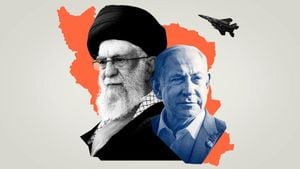Investment trends and economic outlook are under the spotlight as Indian nationals increasingly seek opportunities abroad—an occurrence that's drawing attention even as the Prime Minister, Narendra Modi, promotes the idea of investing within the country. According to statistics, there are record numbers of citizens renouncing their Indian citizenship and transferring funds overseas. This surge raises questions about the perceived state of the Indian economy and the effectiveness of the government’s ‘Make in India’ initiative, which was launched nearly ten years ago with the ambitious goal of positioning India as a global manufacturing hub.
Recent figures released on November 1, 2024, from various sources indicated mixed trends within the Indian economy. Data shows the Goods and Services Tax (GST) collections for October reached Rs 1.87 lakh crore, marking a notable 8.9% increase compared to the same month the previous year. The total GST collections from April to October 2024 reached Rs 12.74 lakh crore, reflecting overall growth of 9.4% year-on-year. While these numbers paint a promising picture, the sentiment among investors appears more cautious.
Particularly concerning is the outflow of foreign portfolio investments (FPIs), which sold off Rs 211.93 crore worth of stocks on the first day of November alone. Domestic institutional investors (DIIs) also registered significant sell-offs, amounting to Rs 377.33 crore. Over the month of October, net sales from foreign investors totaled Rs 11,3858.81 crore. This trend certainly raises eyebrows about the confidence investors have—or lack thereof—in the Indian market.
Despite the recent slight growth indicated by GST collections, rising concerns about political stability and policy effectiveness may be triggering these investment shifts as citizens explore opportunities overseas. The data released by United Nations Conference on Trade and Development (UNCTAD) pointed out how the Indian economic expansion is primarily underpinned by sustained strong investments, consumption patterns, and vibrant services exports.
But why are so many Indian citizens investing abroad? Various factors are at play, including personal circumstances, lifestyle aspirations, and broader socio-economic dynamics at work. One significant issue is the perceived gap between the government's promises and economic realities. Many citizens feel the ‘Make in India’ initiative, positioned as the beacon for local enterprise and job creation, hasn't lived up to expectations. A decade after its rollout, results are debatable, with many still discontented about their prospects within the country.
This sentiment has contributed to the record levels of renunciations of Indian citizenship. For various individuals and families, relocating to foreign nations has become synonymous with securing economic stability, enhanced quality of life and greater educational opportunities. Indian nationals appear to be favoring countries like Canada and the United States, which often offer more extensive social security programs and favorable immigration policies.
To put this trend of investment abroad in perspective, one must appreciate the significance of the changing global dynamics. With the growing opportunities and demand for skilled labor internationally, Indian professionals are seeking greener pastures. According to reports, skilled Indian workers are increasingly attracted to countries known for favorable work cultures, high salaries and progressive lifestyle choices.
By exploring these pathways, many are not only finding business opportunities but also embracing lifestyle changes. The questions around these trends are many: Is this wave of investment abroad justifiable? Are people simply responding to economic pressures, or is it fueled by aspirations deeply rooted in lifestyle changes?
While the Prime Minister reassures citizens about investing back home, the reality remains stark for many. The opacity of political strategies and economic policies has created skepticism among the populace. The rising numbers of those seeking alternative citizenship and investing overseas seem to clash with the optimistic narrative promoted by government officials.
Addressing this disconnect will require concerted efforts not only to boost domestic investments but also to create meaningful engagement and trust with Indian citizens. This involves shifting perceptions about the effectiveness of governmental initiatives, improving infrastructure, and encouraging local entrepreneurship.
The search for new horizons is not just about money—it's about dreams and aspirations. The individuals behind these economic trends are searching for environments where they can thrive personally and professionally. The question remains: how can India assure its citizens of the opportunities available at home to match those found abroad?
On November 1, 2024, additional economic developments emerged highlighting mixed signals for investors. Major indices closed actively, shifting the focus from international investment back to the local market. The Nifty indices ended on a positive note, with key benchmarks seeing slight gains. Such developments reflect the inherent volatility of markets responding to both domestic and international cues. The Dow Jones futures fell as markets prepped for greater fiscal clarity from upcoming U.S. policymaking, whereas Asia saw limited movements amid Tokyo's holiday and pre-election jitters.
All these factors—the GST collections, shifting portfolio investments, legislative actions, and international economic influences—intertwine, creating a complex narrative around India’s economic state. These developments compel stakeholders to reassess where and how they choose to allocate their resources, both financially and personally.
Yet, through all the uncertainty, the continuing investment inflows—albeit cautious—alongside local production initiatives demonstrate underlying potential within the Indian economy. What remains to be seen is how effectively the government can bridge the gap between its vision and the actual circumstances faced daily by its citizens.
The nuances of these economic patterns indicate the vitality with which the Indian economy operates and the adaptability of its citizens as they navigate these tumultuous waters. With time, clarity, and consistent engagement from both government and private sectors, India could very well turn the tide, enticing its citizens to invest back at home and trust the nation’s promising future.
At the end of the day, this whole scenario serves as a reminder: the economic picture is often more complex than it appears, and individuals must weigh multiple factors before making life-altering decisions such as renouncing citizenship or investing abroad. What will the Indian government do to not just promote investment here but to nurture it? That’s the question on everyone’s mind.



